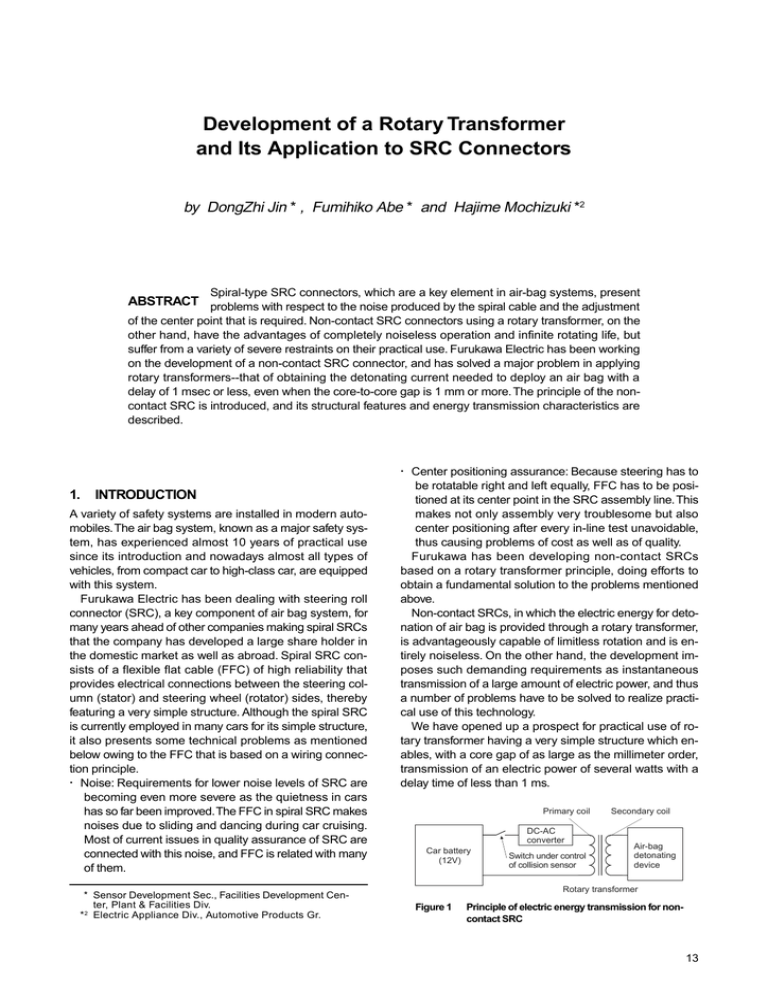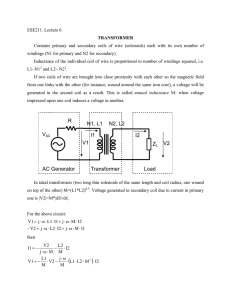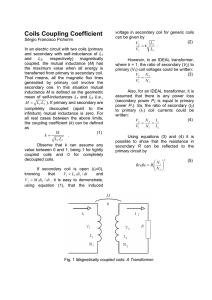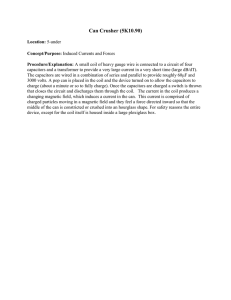Development of a Rotary Transformer and Its Application to SRC
advertisement

Development of a Rotary Transformer and Its Application to SRC Connectors by DongZhi Jin * , Fumihiko Abe * and Hajime Mochizuki *2 Spiral-type SRC connectors, which are a key element in air-bag systems, present ABSTRACT problems with respect to the noise produced by the spiral cable and the adjustment of the center point that is required. Non-contact SRC connectors using a rotary transformer, on the other hand, have the advantages of completely noiseless operation and infinite rotating life, but suffer from a variety of severe restraints on their practical use. Furukawa Electric has been working on the development of a non-contact SRC connector, and has solved a major problem in applying rotary transformers--that of obtaining the detonating current needed to deploy an air bag with a delay of 1 msec or less, even when the core-to-core gap is 1 mm or more. The principle of the noncontact SRC is introduced, and its structural features and energy transmission characteristics are described. 1. INTRODUCTION A variety of safety systems are installed in modern automobiles. The air bag system, known as a major safety system, has experienced almost 10 years of practical use since its introduction and nowadays almost all types of vehicles, from compact car to high-class car, are equipped with this system. Furukawa Electric has been dealing with steering roll connector (SRC), a key component of air bag system, for many years ahead of other companies making spiral SRCs that the company has developed a large share holder in the domestic market as well as abroad. Spiral SRC consists of a flexible flat cable (FFC) of high reliability that provides electrical connections between the steering column (stator) and steering wheel (rotator) sides, thereby featuring a very simple structure. Although the spiral SRC is currently employed in many cars for its simple structure, it also presents some technical problems as mentioned below owing to the FFC that is based on a wiring connection principle. . Noise: Requirements for lower noise levels of SRC are becoming even more severe as the quietness in cars has so far been improved. The FFC in spiral SRC makes noises due to sliding and dancing during car cruising. Most of current issues in quality assurance of SRC are connected with this noise, and FFC is related with many of them. * Sensor Development Sec., Facilities Development Center, Plant & Facilities Div. * 2 Electric Appliance Div., Automotive Products Gr. . Center positioning assurance: Because steering has to be rotatable right and left equally, FFC has to be positioned at its center point in the SRC assembly line. This makes not only assembly very troublesome but also center positioning after every in-line test unavoidable, thus causing problems of cost as well as of quality. Furukawa has been developing non-contact SRCs based on a rotary transformer principle, doing efforts to obtain a fundamental solution to the problems mentioned above. Non-contact SRCs, in which the electric energy for detonation of air bag is provided through a rotary transformer, is advantageously capable of limitless rotation and is entirely noiseless. On the other hand, the development imposes such demanding requirements as instantaneous transmission of a large amount of electric power, and thus a number of problems have to be solved to realize practical use of this technology. We have opened up a prospect for practical use of rotary transformer having a very simple structure which enables, with a core gap of as large as the millimeter order, transmission of an electric power of several watts with a delay time of less than 1 ms. Primary coil DC-AC converter Car battery (12V) Switch under control of collision sensor Secondary coil Air-bag detonating device Rotary transformer Figure 1 Principle of electric energy transmission for noncontact SRC 13 Rotator Secondary coil Gap Rotator Core Steering column Primary coil Stator Figure 2 Stator Basic structure of rotary transformer The principle of operation of the non-contact SRC will be presented in this paper together with its structural features as well as its characteristics in electric power transmission. 2. BASIC PRINCIPLE Figure 1 shows the principle of electric power transmission from the battery to the air bag detonating device. When the switch is activated by a signal from the collision sensor, the DC-AC converter converts DC power from battery into AC power which is applied to the primary coil of the rotary transformer. The electric energy transmitted to the secondary coil is supplied to the air bag detonating device and heats it directly to trigger detonation. This principle is so called "direct transmission" and compares favorably with "indirect transmission" in terms of simple structure, smaller mounting space, and high reliability; in the latter principle, the electric energy is temporarily stored in a storage device on the secondary side of the transformer to effect discharge and detonation as occasion demands. The key component of the non-contact SRC is rotary transformer. Figure 2 shows the basic structure of a transformer in which a ring shaped magnet core with the primary coil is fixed onto the stator, while another ring magnet core with the secondary coil is fixed onto the steering column via the rotator. A gap is provided between the primary and secondary coils making them entirely non-contact with each other. A soft magnetic material is used for these cores to make the magnetic resistance appearing in the magnetic circuit of the two coils small enough, so that an AC electric energy impressed on the primary coil is transmitted to the secondary coil instantaneously. 3. TASKS TO BE ADDRESSSED IN THE DEVELOPMENT OF ROTARY TRANSFORMER It is anticipated that instantaneous transmission of electric energy by means of rotary transformer to the detonating device of automobile air bag system is subject to the following restraints. (1) Squib impedance: The DC resistance of the detonating device is around 2Ω, a quite small value. (2) Detonation delay time: The allowable delay time for 14 air bag to detonate after a collision detection is about 1 ms. (3) Gap distance between magnet cores: Gap distance between magnet cores should desirably be in the order of mm, taking the assembling accuracy and vibration during car cruising into consideration. (4) Transformer diameter: Structurally, the transformer diameter has to be larger than that of steering column. These constraints can be reduced to the requirements for rotary transformers as summarized below. (1) Efficient power transmission over a large gap distance: The higher the coupling coefficient between magnet cores, the more efficient energy transmission becomes. Thus, a rotary transformer that maintains high coupling coefficient irrespective of larger gap distances between cores is desirable. (2) Impedance matching: As is well known, the impedance of a coil is in proportion to the square of the coil diameter. Thus, in the present case where a high efficiency transmission at high frequency under a constraint of large coil diameter has to be achieved, it is very important to realize good impedance matching between the large coil impedance and the small squib impedance. (3) Frequency characteristics of transmission: Direct switching of battery DC power source into pulsed AC power is advisable to make the transmission system economical and simple structured. Accordingly, broadening the frequency bandwidth of transmission characteristics is desirable as much as possible to improve transmission of high frequency components contained in the pulsed AC power, or in other words, to raise the transmission efficiency. (4) Stability: High reliability is required for the air bag system because it is a key safety system. Thus, stabilization technologies are indispensable for such parameters as transformer coupling coefficient, coil impedance, and the like during car cruising. 4. IMPROVEMENT OF COUPLING COEFFICIENT BETWEEN COILS The basic idea for improvement of transmission efficiency, which means high coupling coefficient, consists in how much amount of the AC magnetic flux due to the AC current impressed on the primary coil is made to interlink with the secondary coil. Ordinary transformers use a magnetic material of high permeability to form a magnetic circuit including coils. When the gap shown in Figure 2 is in the order of µm, The AC flux concentrates on the core area because the magnetic resistance of the interlinking magnetic circuit is small enough in comparison to that of the leakage flux circuit, so that the coupling coefficient between coils becomes sufficiently large. However, this configuration presents a problem of large fluctuation in coupling coefficients due to even smaller gap variations. In car assembly line, as mentioned before, it is neces- Furukawa Review, No. 18. 1999 Rotator Rotator Interlinking magnetic path Secondary coil Steering column Primary coil Stator Stator Figure 3 Dispersed distribution of magnetic flux at the gap Stator Rotary transformer prototype sary to provide a large gap allowance. When the gap distances are of the mm order in particular, the ratio of the total magnetic circuit length to the gap distance (filled with air) becomes smaller than the relative permeability of the core, making the effective relative permeability of the whole magnetic circuit entirely dependent on the gap distance. That is, the effective relative permeability of the whole magnetic circuit is determined entirely by the gap distance however high the relative permeability of the core material may be. In the development of a new rotary transformer, we have selected a magnetic material having a comparatively low value in relative permeability placing much importance on the mechanical strength of material. As a result, following advantages were obtained. (1) Impedance matching with detonating resistance: Since the coil inductance is proportional to the effective relative permeability of the magnetic circuit comprising coils, the use of a low permeability material reduces the coil inductance, thus improving the impedance matching of the circuitry. (2) Performance stability: Due to the large gap distance, parameter fluctuations that influence transformer performance can be suppressed regardless of gap distance fluctuations caused by vibration during vehicle cruising. This results in higher reliability. Below are described fundamental technologies that we have developed in order to improve the coupling coefficient between the coils. 4.1 Core Configuration In designing a rotary transformer, it is normal practice to place the end faces of core and coil on the same plane as Metallic shielding layer with slit Slit B1 B31 Secondary coil shown in Figure 2. This structure, however, permits a major portion of fluxes distributed in the gap between the coils to turn into leakage flux degrading the coil coupling conditions. We have developed an enclosed type core shown in Figure 3 intending to reduce the flux leakage; in which both coils are enclosed in the secondary core so that the gap between coils and that between cores lie on different levels with each other. In this configuration, the gap between cores is located apart from the coil end face by a distance equivalent to the coil length, making the fluxes distributed over the core gap less liable to turn into leakage flux. Moreover, since the distributed fluxes themselves eventually interlink with the secondary coil, the configuration can greatly suppress the adverse effect of gap fluctuation to influence the coil coupling coefficient. 4.2 Shielding Layer The well-known shielding effect of metal conductors on high frequency fluxes has been utilized in this development to improve the coupling conditions between coils. The theory will be explained below with the help of illustration in Figure 4. The shielding layer, located as shown in Figure 3, is provided with an insulating slit as shown in Figure 4 so as not to make the layer an electric coil. Fluxes are generated around the primary coil by the current impressed on the coil, comprising two sets of fluxes: the one which interlinks with the secondary coil, denoted as B1 and the other which does not, called leakage flux and is denoted as B2. B2 induces eddy currents in the conductor of the shielding layer as it crosses the layer. While the AC fluxes generated by the eddy current is directed in the reverse direction to B2, some of them lie in the direction of B1. That is, equivalently, whereas B2 is reduced by the eddy current, B1 is increased. This results in an increased ratio of (interlinkage flux / leakage flux), and improves the coupling conditions between coils. In other words, the metal shielding layer functions as a kind of magnetic resistance against AC magnetic fields, causing shielding effects only on leakage fluxes with a degree of effectiveness that depends on its assembling position. The greater the shielding effect, the better the coupling conditions between coils. Theoretically, the shielding effect improves the thicker the shielding layer thickness, the smaller the material's electric conductivity, and the higher the transmission frequency. The use of high frequency is indispensable with the present rotary transformer to reduce the delay time for Sinusoidal signal oscillator 0.01Ω Precision resistor 0.01Ω Precision resistor V1 Shielding layer Load resistor simulating the detonating device (2Ω) Bipolar power source (High frequency current amplifier) B32 Schematic view of shielding layer Figure 4 Primary coil Schematic view of shielding layer and principle of operation V2 B2 Rotary transformer Figure 5 Block diagram of transmission efficiency measuring system 15 120 50% 100 40% G=0 G=0.5mm G=1.0mm G=1.5mm G=2.0mm G=2.5mm G=3.0mm 30% 20% 10% 0% 0 5 10 15 20 25 30 35 40 45 Transmission frequency (Sinusoidal, kHz) 50 Transmitted power (W) Transmission efficiency 60% 80 G=0mm G=0.5mm G=1.0mm G=1.5mm G=2.0mm 60 40 20 0 0 5 10 15 20 25 30 35 40 45 50 Transmission frequency (Pulsed, kHz) Figure 6 Frequency response of transmission efficiency (G: gap distance) 0.01Ω Precision resistor V2 Car battery Pulse generator Current amplifier D Rotary transformer G S Figure 7 High power MOS FET Load resistor modeling the detonating device (2Ω) Block diagram of transmission power measuring system detonation, and this is totally compatible with the shielding technology we have developed. 5. EVALUATION OF BASIC PERFORMANCE OF PROTOTYPES We fabricated prototypes of rotary transformer having enclosed cores along with shielding layers and evaluated their basic performance. 5.1 Frequency Characteristics of Transmission Efficiency The electric power necessary for the detonation of air bag system is several watts. Considering such system parameters as the instantaneous current available from the car battery, transmission attenuation between the battery to the primary coil of rotary transformer, and the conversion efficiency of DC-AC converter, it is estimated that a transmission efficiency of about 20% is practically sufficient for the rotary transformer. Figure 5 shows the basic configuration of the system used to measure transmission efficiencies. Sinusoidal signals of constant voltage having a frequency specified at the oscillator are power amplified by the bipolar amplifier and subsequently are impressed onto the primary coil of a rotary transformer. By measuring the voltages appearing on the two precision resistors (0.01Ω), the currents flowing into the primary coil and the load resistor modeling the detonating device are calculated respectively. Trans- 16 Figure 8 Frequency response of transmitted power (G: gap distance) mission efficiency η is defined as follows. η = V2 × I2 / V1 × I1 where, V1 and I1 are the impressed voltage and current on the primary coil, V2 and I2 are the voltage and current on the load resistor modeling the detonating device respectively. The frequency characteristics of transmission efficiency for the prototype rotary transformer are shown in Figure 6. The following became clear from measurements. (1) Below a transmission frequency of 15 kHz, transmission efficiency improves with higher frequencies, indicating that the shielding effect of the shielding layer increases as the frequency rises. (2) Above 15 kHz, the frequency response somewhat flattens. At high frequencies, while the coupling between coils improves, the matching condition between coil impedance and load deteriorates. These effects counteract each other resulting in a fairly wide frequency bandwidth, which is quite favorable for practical applications. (3) The transmission efficiency declines as the gap distance increases. However, the efficiency decline decreases at larger gap distances. When the gap distance is in the mm order, its small variations are seen to cause little effects on transmission efficiency fluctuations. (4) At transmission frequencies above 20 kHz, a transmission efficiency of more than 25% can be ensured with a gap distance of as large as 2 mm, demonstrating the practicality of the direct transmission method. (5) The delay time can easily be reduced to 1 ms or less due to the use of high frequency transmission, since the transmission delay corresponds to a half cycle time of transmission frequency. 5.2 Evaluation of Power Transmission Characteristics The electric power instantaneously transmitted via rotary transformer from the car battery to the detonating device is influenced by the conversion efficiency of the DC-AC converter as well as by the matching between battery output impedance and transformer input impedance. The available transmitted power was confirmed, simulating actual vehicle assembly, by using a measuring system shown in Figure 7; where a single high power MOSFET was used to constitute a DC-AC converter capable of switching the Furukawa Review, No. 18. 1999 battery DC source into the pulsed source of high frequency. The transmitted power was evaluated based on the product of effective values of voltage and current, where the effective current to flow into the resistor modeling the detonating device was calculated by measuring the voltage on the precision resistor (0.01Ω) on the secondary side. The frequency response of the transmitted power thus evaluated is shown in Figure 8, clarifying the following points. (1) The electric power necessary for detonation can be amply transmitted with a gap distance of as large as 2 mm. (2) The transmittable power declines as the gap distance increases. However, the rate of power decline decreases at larger gap distances in absolute value. When gap distance is in the mm order, similarly with the transmission efficiency mentioned before, its small variations cause transmitted power fluctuations that are negligibly small. (3) The transmittable power demonstrated this time, nearly 50 W at a gap distance of 2 mm or more, can be improved further by optimizing the impedance matching between the coil and the output side of battery. (4) The bandwidth of frequency response is sufficiently wide and flat, and is capable of reducing fluctuations in the transmitted power even with varied spectrums in transmission signals. (5) Peaks of frequency characteristics are seen to have shifted to lower frequencies. This is probably due to the fact that the pulsed power source contains plenty of high frequency components. Furthermore, the transmission delay time was actually measured to be less than 50 µs at a transmission frequency of 10 kHz, a value that surely cause no problem of practical importance. 6. CONCLUSIONS We have described the present situation of development for non-contact SRC based on a rotary transformer principle, which is capable of directly transmitting detonation energy into automobile air bag systems. While the new non-contact SRC is much more advantageous than conventional SRCs for its noise-less as well as limit-less rotation, we have encountered many challenging tasks in putting the SRC into practical use. We believe some of the restrictions on practical applications have successfully been removed by the present development. We intend to realize practical applications of this SRC in the near future by developing peripheral technologies that remain incomplete this time. Manuscript received on July 21, 1998. 17




